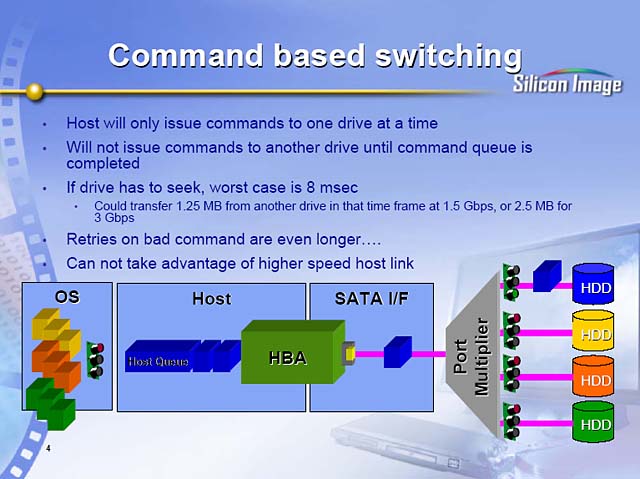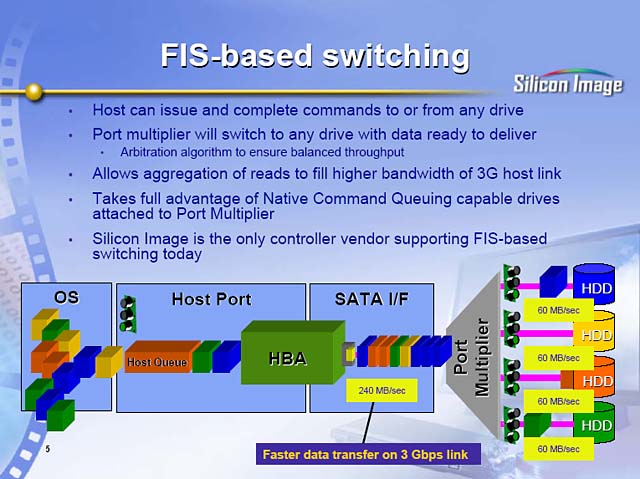IDF:Port Multiplier

通常的点对点SATA:一个端口使用一条线缆连接一个设备

端口复用器Port Multiplier:一个端口使用一条线缆连接多个设备(最多15个),有4个端口就可以连接最多60个

Port Multiplier具有两种切换机制:Command-based Switching和FIS-based Switching,可以翻译为基于命令的切换机制和基于FIS的切换机制,FIS(Frame Information Structure,帧信息结构)是SATA为了实现异步传输数据块而使用的封包,“正常”的SATA设备都使用FIS,除了第一代推出的实际上是包装过的PATA(同步传输)。要支持FIS,也需要驱动的支持,标准的AHCI规范使用了FIS.

Command-based Switching基于命令的切换机制:控制器端口在同一时间只对一个设备发起命令,这种方式就是简单地对端口进行扩展
和PATA相比,SATA的FIS结构允许异步ATA传输,例如,SATA控制器发出读取命令之后可以去干其它事情,驱动器(如,SATA硬盘)准备好数据之后,再主动发送数据给SATA控制器(当然,要具有FIS),控制器并不知道驱动器读取数据需要的时间,在PATA上,只能使用一个块一个块地传输-确认-传输-确认循环,SATA FIS就不需要这样。

FIS-based Switching基于FIS的切换机制:除了发起命令,控制器端口还可以执行来自任何设备的命令,这些都是可以同时进行的,因此提供了最大的性能
显然,对于通常的点对点SATA而言,FIS虽然有用,不过并不明显,在Port Multiplier端口复用器的情况下,FIS可以发挥到最大的效用。FIS-based Switching基于FIS的切换机制允许主控制器不停地发出命令,终端设备则不停工作,并可以在任意的时候发送数据给控制端(当然,Port Multiplier需要进行拥挤管理),这样的结构可以实现最大的并行处理并达到最高的效率。


端口复用器并非仅仅扩展设备数量,通过将SATA本身能力的挖掘,采用了FIS-based Switching基于FIS的切换机制的端口复用器还可以提升性能,这一点上端口复用器很像以前的并行SCSI设备:共享单个总线的带宽,然而所有的设备都可以同时进行工作。
FIS-based Switching基于FIS的切换机制:除了发起命令,控制器端口还可以执行来自任何设备的命令,这些都是可以同时进行的,因此提供了最大的性能
使用了基于FIS的切换机制之后,端口复用器组建的阵列可以得到实质上的提升,在我们的测试当中,来自赛恩斯网络Sans Digital的TR5M-B配合附带的SiI 3132控制卡实现的软件RAID5在传输性能和传输能力上都得到了提高,5个盘的RAID5可以提升应用IOps到原来的2~3倍,从HD Tach RW来看,随机访问时间确实得到降低,从而在随机操作方面比单个硬盘要好不少。就这点上看和以往的320MB/s SCSI相似。
和额外配置SATA端口相比,使用端口复用器可以很快速地增加终端设备的数量而不需要占用过多的扩展槽(每个SATA端口可以支持15个设备,6个端口可以最多支持90个设备),不过,端口复用器的设置仍然略显繁琐,这应该是管理软件的问题。赛恩斯TR5M-B端口复用器表现还算不错,不过我们觉得它有些贵,这可能也是端口复用器显得如此稀少的原因
文章转载自网管之家:http://www.bitscn.com/netpro/stor/200905/161564_12.html
Port MultipliersWhat are port multipliers? Port multipliers are devices that allow a single Serial ATA port to communicate with multiple drives. The port multiplier is transparent to the drives, but the host is aware that it is communicating with multiple drives. Port multipliers typically reside on an enclosure’s backplane and support all standard SATA drives. Typically, Serial ATA (SATA) connectivity consists of a single drive connected to a single controller port via a single cable. The maximum number of drives in an array is predicated on the controller’s port count. The SATA Port Multiplier (SATA PM) permits a change to that point-to-point relationship via port multiplication technology. Port multipliers allow easy, cost-effective storage expansion and enable the aggregation of the performance of multiple drives as well.
 Benefits of Port Multipliers Port multipliers allow cost-effective and expanded drive scalability to storage systems both inside and outside the box. Efficient add-on desktop storage with significantly higher performance than Firewire™ and USB using external connections is assured. The number of extra drives that can be added to a conventional SATA system without port multipliers is limited to the controller’s port count; additional drives mean additional controllers, effectively increasing the cost of the system. The user pays the cost of the extra controller(s) and necessarily forfeits additional PCI slots that may otherwise be needed for other peripheral upgrades. By using port multipliers, a single host adapter occupying a single PCI slot is able to connect many more drives. SATA PM’s simplified cabling topology, where the host is connected to more drives by fewer cables, is another plus for port multiplier connectivity. SATA’s point-to-point relationship in which each port is connected to a single drive via a single cable means overly complicated cabling for multi-drive systems. A reduced cable count contributes to tidier backplanes, simpler drive insertion and removal, improved airflow inside the box, and a more secure system. Command-based or FIS-based Host Support A SATA PM requires that controllers support either command-based switching or FIS (Frame Information Structure)-based switching in order to use port multiplication. Each paradigm offers unique capabilities suited for particular environments. Command-based switching, conceptually similar to a mechanical A/B switch, limits the host to issue commands to only one drive at a time. Commands to other drives will not be issued until the command queue is completed for the prior transaction. Since command-based switching only accesses one drive at a time, it does not take advantage of the potentially higher speed host link. Therefore, command-based switching is ideal for simple drive expansion where capacity is more important than performance.  FIS–based switching offers high performance storage connections to multiple drives simultaneously. The host issues and completes commands to drives at any time. The port multiplier will direct data to any drive ready for I/O. An arbitration algorithm ensures a balanced data flow. Unlike Command-based switching, FIS-based switching allows aggregation of reads to fully use the potentially higher bandwidth of the host link and takes full advantage of the performance benefits of Native Command Queuing (NCQ) on the port multiplier, resulting in aggregated throughput of up to the total bandwidth of the host band link.  Conclusion Port multipliers are simple mechanisms that allow a single active host connection to communicate with multiple drives. They allow easy, cost-effective storage scalability both inside and outside the PC or server with standard SATA drives. Additional controllers are no longer necessarily needed to expand storage. In-box cabling is greatly simplified with fewer cables attached to more drives. Port multipliers allow significantly higher performance in external storage than either USB or Firewire™. | ||
端口复用器
什么是端口复用器?
端口复用器是可令单个串行 ATA 端口与多个驱动器实现通信的设备。 端口复用器不仅可从驱动器上加以识别,主机也能意识到自己正与多个驱动器进行通信。端口复用器通常位于存储设备的背板上,并可支持所有标准 SATA 驱动器。
串行 ATA (SATA) 连接通常由一个驱动器、一个控制器端口及一条连接它们的电缆组成,因此阵列中的最大驱动器数量将取决于控制器的端口数。而 SATA 端口复用器 (SATA PM) 可通过端口复用技术来改变这种点对点的对应关系。端口复用器不仅可实现简单方便、经济高效的存储扩容,还能将多个驱动器的性能加以累积。


端口复用器的优势
端口复用器可通过内置及外置方式令存储系统实现经济高效的驱动器可扩展性,并可通过外部连接为用户提供性能远超 Firewire™ 和 USB 的高效附加桌面存储应用。对未配备端口复用器的传统 SATA 系统而言,可附加驱动器的数量受到控制器端口数量的限制,而更多的驱动器意味着更多的控制器,并会急速增加系统成本。用户不仅要为额外的控制器买单,还不得不占用原本为其他外围设备升级准备的额外 PCI 插槽。通过使用端口复用器,单个主机适配器只需占用一个 PCI 插槽即可连接更多的驱动器。
SATA PM 经简化的连线拓扑则是端口复用器连接的另一项显著优势,它可使主机通过更少电缆连接更多驱动器。SATA 的点对点关系(即一个端口通过一条连接线来连接一块驱动器)使得多驱动器系统的连线变得异常复杂。 而电缆的减少不仅可改善背板整洁度、提高驱动器的易插拔性、增加机箱内的空气流通性,还可使系统更加安全。
基于命令或 FIS 的主机支持
SATA PM 需要得到基于命令或基于 IFS(帧信息结构)交换的控制器支持才能实现端口复用功能。 这两种方式可分别提供适用于不同特定环境的独特功能。
从概念角度而言,基于命令的交换类似于机械式的 A/B 交换,即主机每次只能向一个驱动器发出命令, 在前一个事务的命令队列尚未完成之前,无法向其他驱动器发出命令。由于基于命令的交换每次只能访问一个驱动器,无法充分利用主机链路可能提供的更高速率, 因此仅适用于容量优于性能的简单驱动器扩展。

基于 FIS 的交换可面向多个驱动器同步提供高性能的存储连接。 因此,主机可随时向驱动器发出并完成命令。端口复用器将把数据定向至任何已做好 I/O 准备的驱动器,并通过仲裁算法来确保稳定均衡的数据流。与基于命令的交换不同,基于 FIS 的交换可汇集多个读操作以充分利用主机链路可提供的更高带宽,并充分发挥端口复用器的原生命令队列 (NCQ) 的性能优势,其总吞吐量最高可达主机通信链路的全部带宽。

结论
端口复用器一种可令单个活动主机与多个驱动器连接通信的简单机制,它可通过标准 SATA 驱动器以内置及外置方式帮助 PC 或服务器轻松实现经济高效的存储可扩展性,令存储扩容不再需要额外的控制器, 并能用更少的电缆来连接更多的驱动器,从而极大地简化机箱内的布线。端口复用器可提供远优于 USB 或 Firewire™ 的外部存储性能。






